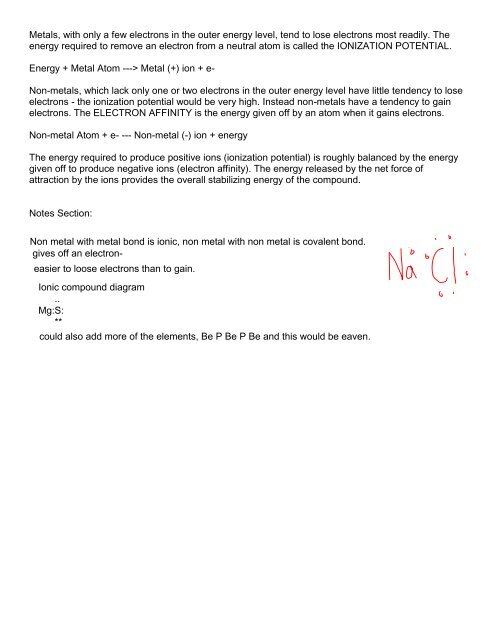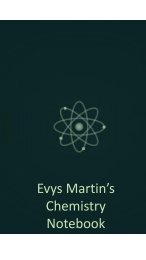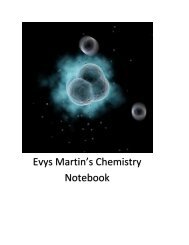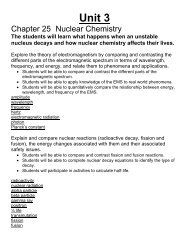Semester 1 Notebook-Martin
You also want an ePaper? Increase the reach of your titles
YUMPU automatically turns print PDFs into web optimized ePapers that Google loves.
The Learning Goal for this assignment is:<br />
Distinguish between bonding forces holding compounds togather and other<br />
attractive forces, including hydrogen bonding and van der waals forces.<br />
Introduction to Covalent Bonding:<br />
Bonding between non-metals consists of two electrons shared between two atoms. Using the Wave<br />
Theory, the covalent bond involves an overlap of the electron clouds from each atom. The electrons<br />
are concentrated in the region between the two atoms. In covalent bonding, the two electrons shared<br />
by the atoms are attracted to the nucleus of both atoms. Neither atom completely loses or gains<br />
electrons as in ionic bonding.<br />
There are two types of covalent bonding:<br />
1. Non-polar bonding with an equal sharing of electrons.<br />
2. Polar bonding with an unequal sharing of electrons. The number of shared electrons depends on<br />
the number of electrons needed to complete the octet.<br />
NON-POLAR BONDING results when two identical non-metals equally share electrons between<br />
them. One well known exception to the identical atom rule is the combination of carbon and hydrogen<br />
in all organic compounds.<br />
Hydrogen<br />
The simplest non-polar covalent molecule is hydrogen. Each hydrogen<br />
atom has one electron and needs two to complete its first energy level.<br />
Since both hydrogen atoms are identical, neither atom will be able to<br />
dominate in the control of the electrons. The electrons are therefore<br />
shared equally. The hydrogen covalent bond can be represented in a<br />
variety of ways as shown here:<br />
The "octet" for hydrogen is only 2 electrons since the nearest rare gas is<br />
He. The diatomic molecule is formed because individual hydrogen atoms<br />
containing only a single electron are unstable. Since both atoms are<br />
identical a complete transfer of electrons as in ionic bonding is<br />
impossible.<br />
Instead the two hydrogen atoms SHARE both electrons equally.<br />
Oxygen<br />
Molecules of oxygen, present in about 20% concentration in air are<br />
also covalent molecules. See the graphic on the left of the Lewis Dot<br />
Structure.<br />
There are 6 electrons in the outer shell, therefore, 2 electrons are<br />
needed to complete the octet. The two oxygen atoms share a total of<br />
four electrons in two separate bonds, called double bonds.<br />
The two oxygen atoms equally share the four electrons.








